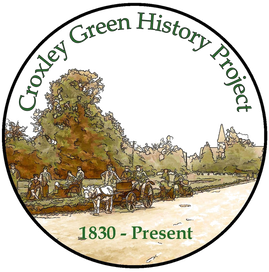Frederick J. T. Heckford
Frederick John Tilbrook Heckford was born in 1872 to parents Frederick and Ann Heckford. Several census entries record his father as a carpenter/joiner.
Fred (as he was known) wrote his original memoirs in note form. He named them 'The Heckford Papers'. They were written by hand on plain paper using a dipping pen and ink. Fountain pens with a reservoir for ink were not always readily available at this time. The memoirs were written in six parts with the following headings:
When his family moved again, this time to Croxley Green, he attended the mixed infants in Yorke Road. Miss Aricie Clarke was the teacher. However, Fred was to return to the Boys' school in Rickmansworth as Croxley Green did not have the opportunity for older boys to receive a separate single sex education until 1894 when the Boys' school was built in the nearby Watford Road.
Unfortunately his family circumstances began to decline and Fred had to leave school at twelve and half years old to seek employment to help with the family income. The school leaving age was much lower at this time and many families were put in the position where school became a second choice and work to help the family income was a priority.
Fred began working as a prospective printer’s devil for Mrs Carter, a widow and a newsagent/printer. Mrs Carter's business involved printed posters, hand bills and the monthly programme of the Rickmansworth Penny Readings, a local newspaper. (A ‘printer's devil’ was an apprentice or errand boy in a printing establishment, who performed a number of tasks, such as mixing tubs of ink and fetching type for setting the printing press).
Fred became involved in setting the type face for the printing and he records that his literary education advanced considerably: he would peruse The Times newspaper as well as The Morning Post. He describes the latter as the aristocrat of British journals and subscribed to it as an adult when it merged with The Daily Telegraph. Fred's duties also included 'machine washer' and 'pig sty scavenger' and his wages were one shilling and sixpence per week. Fred did not stay in this job very long’ He made the decision that he could not contemplate spending five years as an apprentice 'deviller' and sacked himself, aiming for a future with more prospects. He went back to school in Rickmansworth under Henry Brown in January 1885 becoming a monitor teacher earning four pounds a year. He taught Standard Two the three 'Rs' and a little Geography. He recalled he had 'committed to memory maps of the world with the continents and countries in thier juxtapositions'. He also taught Standards Three and Four in Scripture. Fred mentions some of his pupils surnames, Alexander, Asprey through to Wallington and Warrington. His health began to suffer and he became pale and generally debilitated. After thirteen months in the church school he was dismissed. Fred mentions that many of the teachers at the schools he attended believed in corporal punishment. Emily Batchelor used the cane, Aricie Clarke her strong open palm on both sexes, impartially. The 'canings' of Henry Brown would make weals on the schoolboys' bottoms (backsides).
Meanwhile until another opportunity presented itself: Fred accepted a temporary job as stable boy and gardener working for the sisters Misses Hemming, receiving three shillings a week and afternoon tea! His next 'temporary job' was with Peter Robinson, publican of The Artichoke on The Green for many years, working as a farmer's boy. At this time both public houses on The Green had several acres of farmland with orchards. Fred's working day was from sunrise to sunset and he received four shillings a week as wages.
His final 'temporary' job was with the widow of a Watford doctor. Fred describes his job as live in, a page, uniform found, more of a 'scullion' than 'Buttons'. (A scullion is a term used to describe a servant employed to do menial tasks in a kitchen.) He was responsible for cleaning out and relaying the fires (no central heating then!), cleaning the silver, the footwear and the windows. He describes his relationship with the widow as 'notably rude to each other’ and he soon severed their association. On 9th May 1888 aged sixteen years and five months Fred applied to the local John Dickinson paper-making mill for a job. He was accepted initially as a labourer but eventually progressed to become their first chemist. His salary was eight shillings a week. The 1891 census discloses that nineteen year old Fred was living with his parents in New Road, one of six children and employed as a 'Paper making laboratory assistant’.
Two years later Fred married Mary Ann Pettitt on 2nd April 1893. She was also employed at the mill as a Paper-sorter. She was born in Wellingborough Northamptonshire and was living with her family in the Mill Square, later re-named Dickinson Square. Her father also worked at the mill as a Steam engine fitter.
The 1901 census shows the couple living at 23 Dickinson Square with their two daughters, Madge aged seven and Eileen aged one. They continued to live at this address and by 1911 Madge is a clerk at the mill, and Fred and Mary Ann have a son Frank, aged eight years. The census enumerator records only the people actually present in each location, and at the time of the 1911 census Fred does not show up in Croxley Green as on that date he was visiting his brother Arthur William Heckford, a Master Baker, living in Kings Lynn with his wife and eleven year old daughter.
Fred's career progressed steadily at the mill and he was given the opportunity to be part of the advancement of the paper-making industry as a chemist. His potential was soon recognised and he became one of their first leading chemists. The production of different types of paper called on the ability and skills of the chemists who were able to recognise the elements and properties required to create them. Different materials and processing was required for the many finished paper qualities.
Fred wrote many in-house booklets and papers for the company to assist in the education and training of newly employed persons aspiring to become chemists. In 1912, Heckford’s work entitled ‘Elementary Introduction to Paper Making’ was published by the Technical Section of The Paper Maker’s Association of Great Britain.
Fred and his wife became involved in many of the village's social activities especially those held in the Institute/Guildhouse and the hall which was regularly used as a theatre. This had become the hub of the village and he wrote and organised many plays and concerts.
In his latter years Fred's was given the opportunity to have his handwritten memoirs printed into a booklet by the company.During this process the original numbering and titles were changed and were not printed in consecutive order.
Unfortunately the booklet does not show the date it was printed.
The following are the titles of his memoirs as printed:
MEMOIR IV DICKINSON AND RICKMANSWORTH pages 1, 2, 3, 4.
MEMOIR V (cont) pages 4,5, 6.
MEMOIR VI SOME DICKINSON INSTITUTIONS page 7.
MEMOIR VII THE DICKINSON AMATEUR ASSOCIATION FOOTBALL TEAM pages 7, 8.
MEMOIR VIII 1. THE DICKINSON PAPERMAKERS' ASSOCIATION
11.THE CROXLEY COOPERATIVE SOCIETY pages 9, 10.
MEMOIR IX DICKINSONS SOCIO-RECREATIVE EDUCATIONAL INSTITUTION
1.VILLAGE CLUB AND READING ROOM
2.THE DICKINSON INSTITUTE
3. CROXLEY GUILDHOUSE pages 10, 11, 13, 14, 15, 16, 17.
MEMOIR II EXTRACTS FROM MEMOIR II
ENGLAND'S GREATEST SCHOOLBOYS
SLUM KID AND VILLAGE URCHIN
“SHIRT SLEEVE AND VILLAGE COAT”
AN EIGHT HOUR DAY pages 17,18, 19,
YOU CAN READ FRED'S ACCOUNT OF THE EARLY VILLAGE LIFE IN THE MEMOIRS HE HAD PRINTED BELOW
During the celebrations in 1953, for the coronation of Queen Elizabeth II the traditional oak tree sapling planting on The Green was performed by Fred and his wife, the two eldest residents at that time.
Fred died aged eighty-three in 1955.
When the mill site was closed and was later redeveloped into The Bywaters housing estate, one of the streets was named after Fred: Heckford Close.
Fred (as he was known) wrote his original memoirs in note form. He named them 'The Heckford Papers'. They were written by hand on plain paper using a dipping pen and ink. Fountain pens with a reservoir for ink were not always readily available at this time. The memoirs were written in six parts with the following headings:
- Rickmansworth & Croxley Green
- School Work
- Politics
- Paper, Paper-making
- Seventy years of song
- Chess and Draughts
When his family moved again, this time to Croxley Green, he attended the mixed infants in Yorke Road. Miss Aricie Clarke was the teacher. However, Fred was to return to the Boys' school in Rickmansworth as Croxley Green did not have the opportunity for older boys to receive a separate single sex education until 1894 when the Boys' school was built in the nearby Watford Road.
Unfortunately his family circumstances began to decline and Fred had to leave school at twelve and half years old to seek employment to help with the family income. The school leaving age was much lower at this time and many families were put in the position where school became a second choice and work to help the family income was a priority.
Fred began working as a prospective printer’s devil for Mrs Carter, a widow and a newsagent/printer. Mrs Carter's business involved printed posters, hand bills and the monthly programme of the Rickmansworth Penny Readings, a local newspaper. (A ‘printer's devil’ was an apprentice or errand boy in a printing establishment, who performed a number of tasks, such as mixing tubs of ink and fetching type for setting the printing press).
Fred became involved in setting the type face for the printing and he records that his literary education advanced considerably: he would peruse The Times newspaper as well as The Morning Post. He describes the latter as the aristocrat of British journals and subscribed to it as an adult when it merged with The Daily Telegraph. Fred's duties also included 'machine washer' and 'pig sty scavenger' and his wages were one shilling and sixpence per week. Fred did not stay in this job very long’ He made the decision that he could not contemplate spending five years as an apprentice 'deviller' and sacked himself, aiming for a future with more prospects. He went back to school in Rickmansworth under Henry Brown in January 1885 becoming a monitor teacher earning four pounds a year. He taught Standard Two the three 'Rs' and a little Geography. He recalled he had 'committed to memory maps of the world with the continents and countries in thier juxtapositions'. He also taught Standards Three and Four in Scripture. Fred mentions some of his pupils surnames, Alexander, Asprey through to Wallington and Warrington. His health began to suffer and he became pale and generally debilitated. After thirteen months in the church school he was dismissed. Fred mentions that many of the teachers at the schools he attended believed in corporal punishment. Emily Batchelor used the cane, Aricie Clarke her strong open palm on both sexes, impartially. The 'canings' of Henry Brown would make weals on the schoolboys' bottoms (backsides).
Meanwhile until another opportunity presented itself: Fred accepted a temporary job as stable boy and gardener working for the sisters Misses Hemming, receiving three shillings a week and afternoon tea! His next 'temporary job' was with Peter Robinson, publican of The Artichoke on The Green for many years, working as a farmer's boy. At this time both public houses on The Green had several acres of farmland with orchards. Fred's working day was from sunrise to sunset and he received four shillings a week as wages.
His final 'temporary' job was with the widow of a Watford doctor. Fred describes his job as live in, a page, uniform found, more of a 'scullion' than 'Buttons'. (A scullion is a term used to describe a servant employed to do menial tasks in a kitchen.) He was responsible for cleaning out and relaying the fires (no central heating then!), cleaning the silver, the footwear and the windows. He describes his relationship with the widow as 'notably rude to each other’ and he soon severed their association. On 9th May 1888 aged sixteen years and five months Fred applied to the local John Dickinson paper-making mill for a job. He was accepted initially as a labourer but eventually progressed to become their first chemist. His salary was eight shillings a week. The 1891 census discloses that nineteen year old Fred was living with his parents in New Road, one of six children and employed as a 'Paper making laboratory assistant’.
Two years later Fred married Mary Ann Pettitt on 2nd April 1893. She was also employed at the mill as a Paper-sorter. She was born in Wellingborough Northamptonshire and was living with her family in the Mill Square, later re-named Dickinson Square. Her father also worked at the mill as a Steam engine fitter.
The 1901 census shows the couple living at 23 Dickinson Square with their two daughters, Madge aged seven and Eileen aged one. They continued to live at this address and by 1911 Madge is a clerk at the mill, and Fred and Mary Ann have a son Frank, aged eight years. The census enumerator records only the people actually present in each location, and at the time of the 1911 census Fred does not show up in Croxley Green as on that date he was visiting his brother Arthur William Heckford, a Master Baker, living in Kings Lynn with his wife and eleven year old daughter.
Fred's career progressed steadily at the mill and he was given the opportunity to be part of the advancement of the paper-making industry as a chemist. His potential was soon recognised and he became one of their first leading chemists. The production of different types of paper called on the ability and skills of the chemists who were able to recognise the elements and properties required to create them. Different materials and processing was required for the many finished paper qualities.
Fred wrote many in-house booklets and papers for the company to assist in the education and training of newly employed persons aspiring to become chemists. In 1912, Heckford’s work entitled ‘Elementary Introduction to Paper Making’ was published by the Technical Section of The Paper Maker’s Association of Great Britain.
Fred and his wife became involved in many of the village's social activities especially those held in the Institute/Guildhouse and the hall which was regularly used as a theatre. This had become the hub of the village and he wrote and organised many plays and concerts.
In his latter years Fred's was given the opportunity to have his handwritten memoirs printed into a booklet by the company.During this process the original numbering and titles were changed and were not printed in consecutive order.
Unfortunately the booklet does not show the date it was printed.
The following are the titles of his memoirs as printed:
MEMOIR IV DICKINSON AND RICKMANSWORTH pages 1, 2, 3, 4.
MEMOIR V (cont) pages 4,5, 6.
MEMOIR VI SOME DICKINSON INSTITUTIONS page 7.
MEMOIR VII THE DICKINSON AMATEUR ASSOCIATION FOOTBALL TEAM pages 7, 8.
MEMOIR VIII 1. THE DICKINSON PAPERMAKERS' ASSOCIATION
11.THE CROXLEY COOPERATIVE SOCIETY pages 9, 10.
MEMOIR IX DICKINSONS SOCIO-RECREATIVE EDUCATIONAL INSTITUTION
1.VILLAGE CLUB AND READING ROOM
2.THE DICKINSON INSTITUTE
3. CROXLEY GUILDHOUSE pages 10, 11, 13, 14, 15, 16, 17.
MEMOIR II EXTRACTS FROM MEMOIR II
ENGLAND'S GREATEST SCHOOLBOYS
SLUM KID AND VILLAGE URCHIN
“SHIRT SLEEVE AND VILLAGE COAT”
AN EIGHT HOUR DAY pages 17,18, 19,
YOU CAN READ FRED'S ACCOUNT OF THE EARLY VILLAGE LIFE IN THE MEMOIRS HE HAD PRINTED BELOW
During the celebrations in 1953, for the coronation of Queen Elizabeth II the traditional oak tree sapling planting on The Green was performed by Fred and his wife, the two eldest residents at that time.
Fred died aged eighty-three in 1955.
When the mill site was closed and was later redeveloped into The Bywaters housing estate, one of the streets was named after Fred: Heckford Close.
Your browser does not support viewing this document. Click here to download the document.


